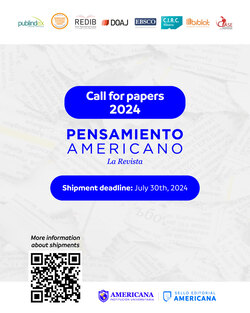The decentralization of science, technology and innovation (STI) capacities in Colombia
DOI:
https://doi.org/10.21803/penamer.16.31.517Keywords:
science, technological innovations, administrative decentralization, ColombiaAbstract
Introduction: The resources for Science, Technology, and Innovation (STI) in Colombia have traditionally been allocated to universities and research centers in the country's largest cities, where the majority of highly qualified researchers are located. This represents a distortion in relation to public policy criteria for balanced growth and capacity-building. Objective: The article aims to present how this distribution has traditionally been carried out by the Ministry of Science, Technology, and Innovation (Minciencias) for STI projects in the country (2014-2018), and how, through a coordinated process, it is possible to decentralize capacities by leveraging the human resources associated with the Sociedad de Doctores e Investigadores de Colombia (SoPhIC). Methodology: To achieve this, geospatial analysis and correlation techniques of competitiveness indicators, departmental category, and the Gini index were used. Results: revealed the capacity and availability of human resources, based on the services that can be offered from and for these regions. Conclusion: These findings demonstrated the possibility and necessity of decentralizing resources to efficiently harness highly qualified human resources.
Downloads
References
Angelelli, P., & Llisterri, J. J. (2003). El BID y la promoción de la empresarialidad: Lecciones aprendidas y recomendaciones para nuevos programas. Washington, D.C., Estados Unidos: Banco Interamericano de Desarrollo.
Capello, M., Figueras, A., Freille, S., & Moncarz, P. (2013). The role of federal transfers in regional convergence in human development indicators in Argentina. Investigaciones Regionales, 27, 33–63. https://dialnet.unirioja.es/servlet/articulo?codigo=4600735
CEPAL. (2017). Escalafón de la competitividad de los departamentos de Colombia 2015. Santiago, Chile: CEPAL.
CEPAL, C. E. para A. L. y el C. (2018). La ineficiencia de la desigualdad. Síntesis. (LC/SES.37/4).
CEPEC, C. de P. en E. C. del R. (2017). Índice departamental de Competitividad. Puntoaparte. Bogotá: Universidad del Rosario.
Clavijo García, C. (2007). La región en la irresuelta reordenación del territorio nacional: De lo económico y funcional a la construcción social del estado nacional. Revista Bitácora Urbano Territorial, 11(1), 240–247. https://www.redalyc.org/articulo.oa?id=74811115
Colombia, C. de la R. de. (2009). Ley 1286 de 2009: Por la cual se modifica la Ley 29 de 1990, se transforma a Colciencias en Departamento Administrativo, se fortalece el Sistema Nacional de Ciencia, Tecnología e Innovación en Colombia. En Diario Oficial (Vol. 2009, Entrega enero 23, pp. 1–19).
Congreso de la República de Colombia. (2012). Ley 1551 de 2012 “Por la cual se dictan normas para modernizar la organización y el funcionamiento de los municipios” (p. 29).
Congreso de la República de Colombia. (2019). Ley 1951 “Por la cual se crea el Ministerio de Ciencia, Tecnología e Innovación, se fortalece el sistema nacional de Ciencia, tecnología e innovación y se dictan otras disposiciones” (p. 16). Diario Oficial. http://svrpubindc.imprenta.gov.co/diario/index.xhtml;jsessionid=9372419edebb706972a7c81d97d5
Constitución de Colombia. (1991). CONSTITUCIÓN POLÍTICA DE COLOMBIA 1991 Actualizada con los Actos Legislativos a 2016 (p. 170). https://doi.org/10.1021/ja807455s
Contaduría, G. de la N. (2017). Resolución 593 de 2017 “Por la cual se expide la certificación de categorización de las entidades territoriales (Departamentos, Distritos y Municipios) conforme a lo dispuesto en las Leyes 136 de 1994 y 617 de 200 y 1551 de 2012” (p. 34).
Cristina, I., Sepúlveda, Q., Nieto, Y. O., & Parra, D. J. Q. (2021). Relación entre Capacidad de Innovación e Índice de Innovación en América Latina. Journal of Technology Management & Innovation, 16(3), 47-56. http://dx.doi.org/10.4067/S0718-27242021000300047
DNP. (2009). Conpes 3582: POLÍTICA NACIONAL DE CIENCIA, TECNOLOGÍA E INNOVACIÓN. In CONPES. Recuperado el 10 de diciembre de 2021, de http://www.colombiacompetitiva.gov.co/sncei/Documents/conpes-3582-de-2009.pdf
DNP. (2015a). CONPES 3834: Lineamientos de política para estimular la inversión privada en ciencia, tecnología e innovación a través de deducciones tributarias (Documento Conpes). Recuperado el 1 de diciembre de 2021, de http://www.colciencias.gov.co/sites/default/files/upload/conpes3834-beneficiostributarios.pdf
DNP. (2015b). Documento Borrador de POLÍTICA NACIONAL DE DESARROLLO PRODUCTIVO (Documento CONPES).
Escobar, J. F., Cardenas, M. F., Fernandez-Jardon, C. M., Bedoya, I. B., Herrera, J. F., Mosquera, J., Arroyave, J., & Argudelo, L. C. (2016). Agentes, funciones e impactos de los sistemas regionales de innovación (J. F. Escobar, M. F. Cardenas, & T. Editores (eds.); 1st ed.). Medellín: Servicio Nacional de Aprendizaje SENA.
Escobar, J. F., Fernandez-Jardon, C. M., Bedoya, I. B., & Mosquera, J. (2016). Ciencia, tecnología e innovación y su impacto en la generación de riqueza: análisis del PIB per cápita en 13 países Iberoamericanos. Revista Espacios, 37(35), 19. http://www.revistaespacios.com/
Escobar, J. F., & Herrera, J. F. (2015). Los planes estratégicos para el desarrollo de la ciencia, la tecnológica y la innovación como herramienta hacia la competitividad regional y su real impacto. Conference: ALTEC 2015.
Ezcurra, R. (2019). Regional disparities and within-country inequality in the European Union. Revista de Economía Mundial, (51), 139–162. https://doi.org/10.33776/rem.v0i51.3907
Foray, D., & Lundvall, B.-A. (1996). The Knowledge - based Economy: From the Economics of Knowledge to the learning Economy (O. Documents (ed.)). Employment and Growth in the Knowledge-based Economy. The economic impact of knowledge, (115-121). Boston: Butterworth Heinemann.
González Díaz, J. E. ., & Cardona Arbeláez, D. A. (2019). La arquitectura y la gestión organizacional. Ad-Gnosis, 8(8). https://doi.org/10.21803/adgnosis.v8i8.364
Grosser Villar, G. T., & Carrasco-Henríquez, N. (2019). Rezago, sector forestal y trampas territoriales. La provincia de Arauco. Bitácora Urbano Territorial, 29(2), 143–150. https://doi.org/10.15446/bitacora.v29n2.69730
Henao-Rodríguez, C., Lis-Gutiérrez, J. P., Gaitán-Angulo, M., Malagón, L. E. & Viloria, A. (2018). Econometric Analysis of the Industrial Growth Determinants in Colombia. En: Wang, J., Cong, G., Chen, J., Qi, J. (eds) Databases Theory and Applications. ADC 2018. Lecture Notes in Computer Science, 10837. Springer, Cham. https://doi.org/10.1007/978-3-319-92013-9_26
Jimenez, J. P. (2015). Desigualdad, concentración del ingreso y tributación sobre las altas rentas en América Latina. En Libros de la CEPAL (Vol. 134). https://doi.org/10.15446/cuad.econ.v35n67.52441
Leydesdorff, L., Wagner, C. S., Porto-Gomez, I., Comins, J. A., & Phillips, F. (2019). Synergy in the knowledge base of U.S. innovation systems at national, state, and regional levels: The contributions of high-tech manufacturing and knowledge-intensive services. Journal of the Association for Information Science and Technology, 70(10), 1108–1123. https://doi.org/10.1002/asi.24182
Lundvall, B.-Å. (1992). National System of Innovation. Towards a Theory of Innovation and Interactive Learning (P. Publishers. (ed.)). London: Anthem Press.
Meisel Roca, A., Hahn, L. (2020). Regional Economic Inequality in Colombia, 1926–2018. In: Tirado-Fabregat, D.A., Badia-Miró, M., Willebald, H. (eds) Time and Space. Palgrave Studies in Economic History. Palgrave Macmillan, Cham. https://doi.org/10.1007/978-3-030-47553-6_8
MINCIT. (2021). Categorización municipios. Recuperado el 30 de noviembre de 2021, de https://www.colombiaagil.gov.co/tramites/intervenciones/categorizacion-municipios
Nieto, V. M., Timoté, J. A., Sánchez, A. F., & Villareal, S. (2015). La clasificación por tamaño empresarial en Colombia: Historia y limitaciones para una propuesta. Archivos de Economía - Departamento Nacional de Planeación, 434(C14 L11 L52), 1–34. https://colaboracion.dnp.gov.co/cdt/estudios%20econmicos/434.pdf
Pardo Martínez, C.I., Cotte Poveda, A. (2021). Science, technology, innovation, theory and evidence: the new institutionality in Colombia. Quality & Quantity, 55, 845–876. https://doi.org/10.1007/s11135-020-01032-3
Porto-Gomez, I., Zabala-Iturriagagoitia, J. M., & Leydesdorff, L. (2019). Innovation systems in México: A matter of missing synergies. Technological Forecasting and Social Change, 148. 119-721. https://doi.org/10.1016/j.techfore.2019.119721
Quintana, L., Salas, C., & Correa-Quezada, R. (2019). Crisis, employment and inequality in Latin America: A national and regional analysis between Mexico, Brazil and Ecuador. Investigaciones Regionales, 2019(43), 129–147.
Quintero Ramírez, S., & Ramírez Giraldo, D. P. (2019). El aprendizaje en los sistemas regionales de innovación desde la perspectiva de la modelación basada en agentes (J. C. Rodas Montoya (ed.); Primera Ed). Bogotá: Editorial Universidad Pontificia Bolivariana.
Ramírez, J. C., Parra-Peña, R. I., González, L., & Corredor, A. (2013). Escalafón de la competitividad de los departamentos de Colombia, 2012-2013 (Serie Estu). Cepal, Naciones Unidas.
RIMISP - Centro Latinoamericano para el Desarrollo Rural. (2017). Pobreza y desigualdad. Informe Latinoamericano 2017 (F. Grez (ed.)). Santiago de Chile: Rimisp - Centro Latinoamericano para el Desarrollo Rural.
Robledo Velásquez, J., Gomez, F. A., & Restrepo, J. F. (2009). Relación entre capacidades de innovación tecnológica y el desempeño empresarial y sectorial. En Encuestas, Datos Y Descubrimiento De Conocimiento Sobre La Innovación En Colombia. Bogotá: Universidad Nacional de Colombia.
Salazar, M., Guillard, C. & Crespi, G. (2019). The Colombian Observatory of Science and Technology. Between Relevant Context and Internationally Comparable Indicators. Inter-American Development Bank.
Sánchez-Torres, R. M. (2017). Desigualdad del ingreso en Colombia: Un estudio por departamentos. Cuadernos de Economía, 36(72), 139–178. https://doi.org/10.1016/S0210-0266(11)70011-5
SENA. (2018). Misión y Visión SENA. Sitio Oficial. Recuperado el 15 de diciembre de 2021, de http://www.sena.edu.co/es-co/sena/Paginas/misionVision.aspx
SENNOVA. (2019). Geoportal SENNOVA. Informes Estadísticos. Recuperado el 15 de diciembre de 2021, de http://geoportal.sennova.co/
Silva, I. (2003). Disparidades, competitividad territorial y desarrollo local y regional en América Latina. En Serie Gestión Pública (Issue 33). Santiago de Chile: Instituto Latinoamericano y del Caribe de Planificación Económica y Social (ILPES) https://doi.org/ISBN: 92-1-322158-4
SNCCTI. (2016). Gobernanza Sistema Nacional de Competitividad, Ciencia, Tecnología e Innovación. Web Oficial. Recuperado el 15 de diciembre de 2021, de http://www.colombiacompetitiva.gov.co/Paginas/SNCEI.aspx
Solow, R. M. (2001). After Technical Progress and the Aggregate Production Function. In: New Developments in Productivity Analysis, January (173–178). Chicago: University of Chicago Press.
Terrádez-Gurrea, M. (2006). Análisis De Componentes Principales. Revista Chilena de Obstetricia y Ginecolog, 71(1), 1–11. https://doi.org/10.4067/S0717-75262006000100004
Thomas, V. J. & Maine, E. (2019). Impact of regional systems of innovation on the formation of university spin-offs by biomedical star scientists. International Journal of Entrepreneurship and Small Business, 37(2), 271–287. https://doi.org/10.1504/IJESB.2019.100108
Tovma, N. A., Shurenov, N. B., Bimendiyeva, L. A., Kozhamkulova, Z. T., & Akhmetova, Z. B. (2020). Territorial marketing and its role in determining regional competitiveness. Evaluating supply chain management. Uncertain Supply Chain Management, 8(1), 1–16. https://doi.org/10.5267/j.uscm.2019.10.001
Downloads
Published
Versions
- 2023-08-15 (4)
- 2023-08-14 (2)
Issue
Section
License
Copyright (c) 2023 Pensamiento Americano

This work is licensed under a Creative Commons Attribution-NonCommercial-NoDerivatives 4.0 International License.
The author or authors of an article accepted for publication in the Journal Pensamiento Americano will transfer all of the patrimonial rights to the American University Corporation free of charge, within which are included: the right to edit, publish, reproduce and distribute both print media as digital, in addition to include in article in international indexes and / or databases, likewise, the Editorial Seal is authorized to use the images, tables and / or any graphic material presented in the article for the design of covers or posters from the same magazine. By assuming the patrimonial rights of the article, it may not be partially or totally reproduced in any printed or digital media without its express permission.
AUTHORITY ASPECTS
For the Pensamiento Americano Journal, all the authors of an article have made substantial contributions to the research and the manuscript, and they share the responsibility when the article presents errors, fraud in some way or violations of copyright.
After submitting an article, the journal does not accept the addition, deletion or change in the order of the authors, in addition we reserve the right to release the article when it has been submitted to the journal and under no circumstances will American Thought accept the article. withdrawal of an article during any phase of the editorial process






